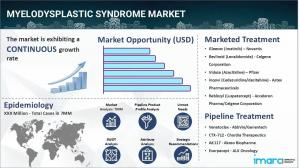Myelodysplastic Syndrome Market Epidemiology Report 2025-2035: Pipeline Therapies, Drugs Sales, and Regional Outlook
The report provides a detailed analysis of the current myelodysplastic syndrome marketed drugs and late-stage pipeline drugs.
BROOKLYN, NY, UNITED STATES, July 6, 2025 /EINPresswire.com/ -- How big is the MDS market?The myelodysplastic syndrome market size reached a value of USD 2.4 billion in 2024. Looking forward, IMARC Group expects the 7MM to reach USD 4.8 billion by 2035, exhibiting a growth rate (CAGR) of 6.29% during 2025-2035.
What is myelodysplastic syndrome (mds)?
Myelodysplastic Syndromes (MDS) refer to a group of blood cancers that stem from the bone marrow. The diseases are marked by the abnormal growth and dysfunction of blood-forming stem cells, which results in insufficient production of healthy erythrocytes, leukocytes, and platelets. This condition results in a range of cytopenias, including anemia, leukopenia, and thrombocytopenia which are hallmarked by a triad of symptoms. From the clinical perspective, patients suffer from symptoms such as fatigue, dyspnea, and frequent infections alongside easy bruising and bleeding which stems from the lower count of blood cells. In particular, the most critical concern associated with this syndrome is its propensity to transform into acute myeloid leukemia, a more aggressive form of blood cancer. There is also considerable variability in the prognosis of patients with MDS due to some genetic abnormalities and how severe their cytopenias are. The term “diverse collection of hematologic neoplasms” which portrays MDS "with heterogeneity in pathobiology due to its genetic landscape" exemplifies the core difficulty in finding MS treatments. Such intrinsic complexities indicate that no single cure is probable and reinforces the need for more effective and easier-to-tolerate treatment approaches.
This situation drives the market demand for innovative therapies and personalized medicine as the industry works to resolve the different forms of the disease.
The MDS market includes and encompasses diagnostic devices, therapeutic interventions, and supportive care. Therapeutic strategies include treatment with hypomethylating agents, chemotherapy, immunomodulatory drugs, stem cell transplantation, and other newly developed targeted therapies. The remarkable growth of the MDS market stems from the increasing elderly population worldwide and the prevalence of rare blood cancers. MDS predominantly affects people older than sixty years, especially those aged sixty five and above. This demographic shift creates a natural increase in MDS cases, thereby increasing the patient base as well as the need for diagnostic and treatment options, which in turn expands the market. This trend provides continuous foundational support for the expansion of the market.
Latest Trends Driving Innovation in MDS
A notable development in the MDS market is the use of personalized medicine, which is supported by advanced diagnostic tools. Molecular characterization of MDS through next generation sequencing (NGS) improves the accuracy and precision of diagnostics, classification, and risk assessment for the patients.
The use of systems like Molecular International Prognostic Scoring System IPSS-M and others provide thorough profiling of the patient's genetics and assists in shaping treatment pathways in accordance with the person's basic molecular and clinical traits. The attention provided to NGS and IPSS-M goes beyond simple NGS diagnostics towards enabling personalized treatment paradigms. Because of the wide variety of genetic abnormalities present in MDS, such precision is critical. Clarity regarding particular mutations allows the clinician to make informed decisions concerning the most effective therapies and the best timing for interventions, which may include metabolic-controlled hematopoietic stem-cell transplantation.
Furthermore, the overall MDS treatment landscape is changing with the advent of new therapies. luspatercept is effective for treating lower risk MDS, especially with SF3B1 mutations, since it enhances late-stage erythroid maturation, helping patients achieve transfusion independence. Another emerging agent that has promise is imetelstat, a telomerase inhibitor which induces transfusion independence and also exerts disease-modifying effects by markedly decreasing mutation allele frequencies in responsive patients. The availability or luspatercept and imetelstat illustrate how urgent the need is for these new and more effective, and more MDS tolerable, strategies.
Transfusion persistence constitutes a rhythmic decline in the quality of life and automated survival for patients. Therefore, transfusion independence is one of the most striking outcomes and crucial progress is achieved through precise therapeutic interventions beyond mere supportive initiatives. Such tailored therapies have the potential to modify life expectancy along exactly as they improve it.
Moreover, the recent combination therapy trend shows promise to modify treatment efficacy while overcoming resistance. Regulatory movements like the FDA's rough guide on MDS drug and biological products development in 2025 demonstrate active engagement toward new initiatives. The primary concern is also the focus, which shifts towards combination therapy. As most MDS therapies tend to be non-curative, a large portion of patients relapse or resist the first lines of treatment—this becomes the focal point of combining therapy. Pharmaceutical companies intend to replace numerous pathways alternately to enhance responsiveness and postpone resistance, improving long-term outcomes instantly. For diseases that rely heavily on mono-agent therapies, these approaches are utterly critical.
Request to get a PDF Sample Report: https://www.imarcgroup.com/myelodysplastic-syndrome-market/requestsample
Key Highlights:
According to Orphanet, the global prevalence of MDS ranges from one to nine per 100,000.
The annual incidence of MDS is around 4 per 100,000 people, based on the United States Surveillance.
The typical age of presentation is 70 years, and the likelihood of developing MDS rises with age.
This condition is particularly common among white men.
This report also provides a detailed analysis of the current myelodysplastic syndrome marketed drugs and late-stage pipeline drugs.
In-Market Drugs
Drug Overview
Mechanism of Action
Regulatory Status
Clinical Trial Results
Drug Uptake and Market Performance
Late-Stage Pipeline Drugs
Drug Overview
Mechanism of Action
Regulatory Status
Clinical Trial Results
Drug Uptake and Market Performance
Competitive Landscape With Key Players:
The competitive landscape of the myelodysplastic syndrome market has been studied in the report with the detailed profiles of the key players operating in the market.
Novartis
Celgene Corporation
Pfizer
Astex Pharmaceuticals
Acceleron Pharma
AbbVie/Genentech
Chordia Therapeutics
Akeso Biopharma
ALX Oncology
Novartis Oncology
Kindly note that the drugs in the above table only represent a partial list of marketed/pipeline drugs, and the complete list has been provided in the report.
Buy the full Myelodysplastic Syndrome Market Epidemiology Report with TOC: https://www.imarcgroup.com/checkout?id=7228&method=809
7 Major Countries Covered
United States
Germany
France
United Kingdom
Italy
Spain
Japan
IMARC Group Offers Other Reports:
Type 2 Diabetes Market https://world.einnews.com/pr_news/820405295/type-2-diabetes-market-size-in-the-7mm-is-estimated-to-exceed-usd-42-8-billion-by-2035
ANCA Vasculitis Market https://www.einpresswire.com/article/820354434/anca-vasculitis-market-size-epidemiology-trends-treatment-and-forecast-2025-2035
Erectile Dysfunction Market https://www.einnews.com/pr_news/820367642/erectile-dysfunction-market-size-to-reach-usd-4-5-billion-by-2035-epidemiology-report-by-imarc-group
hemophilia A market https://www.einpresswire.com/article/821434221/hemophilia-a-market-epidemiology-report-2025-2035-drug-pipeline-treatment-trends-rising-incidence-prevalence
Age‑Related Macular Degeneration Market https://www.einpresswire.com/article/826532968/age-related-macular-degeneration-market-size-epidemiology-drugs-pipeline-therapies-and-regional-outlook-2025-2035
Breast Cancer Market https://www.einpresswire.com/article/826557305/breast-cancer-epidemiology-report-in-market-drugs-treatment-trends-rising-incidence-prevalence-2025-2035
Acute Respiratory Distress Syndrome Market https://www.einpresswire.com/article/826678753/acute-respiratory-distress-syndrome-market-size-in-the-7mm-to-reach-usd-5-070-9-million-by-2035
Elena Anderson
IMARC Services Private Limited
+1 631-791-1145
email us here
Legal Disclaimer:
EIN Presswire provides this news content "as is" without warranty of any kind. We do not accept any responsibility or liability for the accuracy, content, images, videos, licenses, completeness, legality, or reliability of the information contained in this article. If you have any complaints or copyright issues related to this article, kindly contact the author above.
It’s Boba Time Expands to Texas, Deepens LA Roots with New August Store Openings
Japan Ski Experience Nominated in 2025 Ski Asia Awards
Digitech Auto Solutions Offers Same-Day Gauge Repair Service for GM Instrument Clusters
Więcej ważnych informacji
 Jedynka Newserii
Jedynka Newserii

 Jedynka Newserii
Jedynka Newserii

Handel

1 października ruszy w Polsce system kaucyjny. Część sieci handlowych może nie zdążyć z przygotowaniami przed tym terminem
Producenci, sklepy i operatorzy systemu kaucyjnego mają niespełna dwa miesiące na finalizację przygotowań do jego startu. Wówczas na rynku pojawią się napoje w specjalnie oznakowanych opakowaniach, a jednostki handlu powinny być gotowe na ich odbieranie. Część z nich jest już do tego przygotowana, część ostrzega przed ewentualnymi opóźnieniami. Jednym z ważniejszych aspektów przygotowań na te dwa miesiące jest uregulowanie współpracy między operatorami, których będzie siedmiu, co oznacza de facto siedem różnych systemów kaucyjnych.
Ochrona środowiska
KE proponuje nowy cel klimatyczny. Według europosłów wydaje się niemożliwy do realizacji

Komisja Europejska zaproponowała zmianę unijnego prawa o klimacie, wskazując nowy cel klimatyczny na 2040 roku, czyli redukcję emisji gazów cieplarnianych o 90 proc. w porównaniu do 1990 rok. Jesienią odniosą się do tego kraje członkowskie i Parlament Europejski, ale już dziś słychać wiele negatywnych głosów. Zdaniem polskich europarlamentarzystów już dotychczas ustanowione cele nie zostaną osiągnięte, a europejska gospodarka i jej konkurencyjność ucierpi na dążeniu do ich realizacji względem m.in. Stanów Zjednoczonych czy Chin.
Handel
Amerykańskie indeksy mają za sobą kolejny wzrostowy miesiąc. Druga połowa roku na rynkach akcji może być nerwowa

Lipiec zazwyczaj jest pozytywnym miesiącem na rynkach akcji i tegoroczny nie był wyjątkiem. Amerykańskie indeksy zakończyły go na plusie, podobnie jak większość europejskich. Rynki Starego Kontynentu nie przyciągają jednak już kapitału z taką intensywnością jak w pierwszej części roku. Z drugiej strony wyceny za oceanem po kolejnych rekordach są już bardzo wysokie, a wpływ nowego porządku celnego narzuconego przez Donalda Trumpa – na razie trudny do przewidzenia. W najbliższym czasie na rynkach można się spodziewać jeszcze większej zmienności i nerwowości, ale dopóki spółki pokazują dobre wyniki, przesłanek do zmiany trendu na spadkowy nie ma.
Partner serwisu
Szkolenia

Akademia Newserii
Akademia Newserii to projekt, w ramach którego najlepsi polscy dziennikarze biznesowi, giełdowi oraz lifestylowi, a także szkoleniowcy z wieloletnim doświadczeniem dzielą się swoją wiedzą nt. pracy z mediami.



![Nestlé w Polsce podsumowuje wpływ na krajową gospodarkę. Firma wygenerowała 0,6 proc. polskiego PKB [DEPESZA]](https://www.newseria.pl/files/1097841585/fabryka-nesquik_1,w_85,r_png,_small.png)




.gif)

 |
| |
| |
|